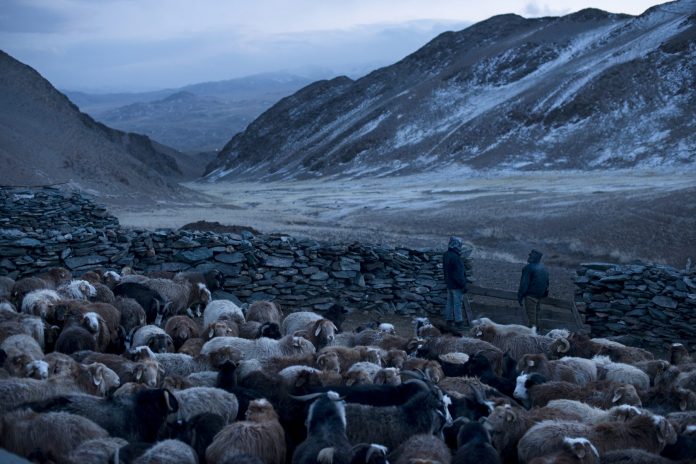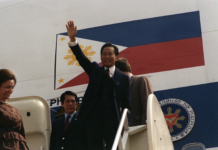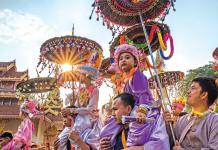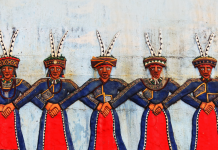Modernisation is emptying Mongolia’s steppe. Are we seeing the last nomadic generation?
Text Zigor Aldama
Photos Miguel Candela & Zigor Aldama
It’s seven in the morning, but the frosty Mongolian steppe is still pitch black. With a thick blanket of clouds covering the starry sky, darkness is pierced by the hundreds of eerie lights emanating from the eyes of a large sheep herd. They stare at whoever dares to come out of the ger – the nomads’ traditional yurt – into the icy open air, some 35°C below zero. Their woolly faces are covered in ice. They have survived these bitter temperatures by staying very close to one another; this morning, they are huddled behind a wooden enclosure in the middle of nowhere.

But Shuukhaz, a lean 17-year-old, is not afraid of the cold. Wearing just a thin jacket and no gloves, he brandishes a flashlight and starts the daily routine in the barn where the family’s cows and horses spend the winter nights. The eldest of the family’s two daughters, Margad Erdene, soon joins him to milk the animals.
With the first lazy sun rays splintering through the clouds, a spectacular landscape takes shape. Arid mountains become imposing shadows on the horizon, a white carpet rolling up to them. There is nothing else to interrupt the stark vastness.

“The closest family we know of is about 30 kilometres away,” says Damb Batnasan, the children’s father. His wife, Batsuren Tsetsegmaa, is making soup for breakfast in the rudimentary kitchen, burning dung to heat the ger. “We are also the youngest couple around,” she adds. The couple will turn 30 soon, but Damb is not optimistic about their way of life: “I believe nomads will disappear with our generation.”
He points to his daughters. The youngest is just two years old, but she already knows how to slide her forefinger along the screen of a smartphone with surprising dexterity. The oldest, aged seven, is glued to a TV series and longs to get back to the closest city, Zaamar, after the school holidays are over. “I want to go to the school with other kids. Staying here is boring,” she laments. “It’s also hard,” her father adds.
The family owns 30 horses, a dozen cows, and a herd of 500 cattle – just enough to get by. “We are always worried about the winter. A very cold season could kill many of our sheep and make it difficult for us to survive,” Damb says.
The family has changed locations four times in search of better pastures, which proves problematic for the kids’ education. “Right now, they go to school and live in Zaamar city during term-time. So we just meet during their holidays,” their mother explains. They are celebrating the lunar new year, and some friends have come to visit.
“My dream is to become a mechanic and buy an apartment in Ulaanbaatar, the capital, where I can have more freedom and find a girl who suits me, and not the one my parents want me to marry,” Shuukhaz says with a grin.
Still, Damb won’t give up. “We were born on the steppe and we love to be in contact with Nature. I’m an avid horse rider and I wouldn’t fit in the city. But I know my daughters won’t follow our steps. We will grow old alone,” he says, unable to conceal his sadness.

Eagle hunter Hairathan Sernehan is a case example of what comes next. The five children of the 52-year-old flew the nest a while ago. He now manages the cattle alone. “Now, they just come to visit from time to time. And only because they worry that my wife and I are getting too old to take care of the animals. They enjoy their new life in Olgii – the capital of Bayan–Ölgii Province. So I guess that, when the time comes, they will sell the cattle and take care of us in the city.”
Even if Genghis Khan’s portrait is the main feature in Hairathan’s winter hut, he does not care much about the dawn of the nomadic life that has characterised Mongolian culture for thousands of years. He pities the fact that many of the traditions that make the country proud may also die with his generation: “Eagle hunting, for example. You just need to see our age. We are all well over 50. And even though there are some youngsters still interested in learning, their numbers are decreasing fast.”
Only the traditional wrestling and horse-riding customs are thriving, and that’s mainly because the athletes can also compete in similar modalities recognised abroad. “It’s not because of tradition, but for money,” Hairathan says, critically. “Many think of wrestling because they want to become sumo stars in Japan.”
As many other elders do, Hairathan blames TV and the Internet for the change, but his children refute this claim: “Times have changed. We see the world now. And we just want to live more comfortably,” his daughter, Aikejan, says.
Other members of the younger generation also mention the need to get a good education in order to achieve satisfactory personal development – something that only cities can offer. “I like to live in Nature and be very close to the family. But I also want to be independent, become a professional in a technical field, and marry whoever I want, not just the girl in the closest ger,” Jariber Bimolda, 18, says. He feels the mining industry has good opportunities, and he knows there is a need for skilled personnel, not labourers.
According to statistics from the United Nations Development Programme (UNDP), around 900,000 of the three million inhabitants of Mongolia still roam a territory that is three times the size of France, but NGOs estimate that around 40,000 people settle down every year. Most settle on the outskirts of Ulaanbaatar, a burgeoning city where the surrounding mountain slopes are now full of gers and small wooden houses.
With rapid urbanisation, social problems have proliferated. Unemployment is at around 60 percent in these new settlements, which in turn instigates other issues, such as alcoholism and crime.
Certainly, life in the city is not even close to what Erden Bat dreamt of. “We didn’t have enough cattle to lead a good life, so we decided to sell [them] and requested the 0.7 hectares of land we are entitled to by law in Ulaanbaatar,” he explains. The government allocated the family a plot about 10 kilometres east of the city centre, where they built their ger. “It was supposed to be a temporary home. But, with prices for apartments starting at around 2.5 million tugrik (around USD1,000) per square metre, there is no way we will move soon,” he says. His two children, Maral, 17, and Gankhoyag, 20, have received an education, but can’t find work, and spend most of the day watching TV and playing on their phones.

“My father just does odd jobs, and my mother gets some money as a tailor, but nothing steady,” Maral shares. “At least, in the countryside, there is always something to do and something to eat,” her brother adds. But neither of them would be willing to return to the steppe. “We’ve become lazy,” he says bluntly.
The Mongolian government is aware of the challenges ahead. In a 2009 report from the World Bank, it cited climate change as one of the main threats to nomadic life. Since 1940, temperatures have risen 2.14°C, and rain has become unpredictable – more abundant in winter and scarce in summer; the Gobi Desert has expanded about 150 kilometres north.
The Ministry of the Environment expects temperatures to keep rising throughout the century, with extreme weather set to become a more common occurrence. The consequences of this could be a decline in crop yields, and a threat to livestock on which many nomads rely.
“Without animals, it’s impossible to live in the countryside,” Ankhtsetseg Bardal confirms. “And you need at least a herd of 500 heads to make a decent living.” Since her family couldn’t afford a herd that large, they decided to journey the 400 kilometres to Ulaanbaatar a few years ago. With them, the young couple took their newborn baby girl, and Bardal’s husband’s 89-year-old grandmother. “She has a hard time adjusting to the city. But we thought we would be able to offer her a better life here,” Bardal says.
Bardal is pregnant again and her husband struggles to find construction work due to the crisis that has halted Mongolia’s economic growth, plummeting from 17.5 percent in 2011 to 0.1 percent in 2016, according to the World Bank. Their future looks bleak, made more so by the many other stories that point to a loss of nomadic culture in exchange for urban survival.
Such was the case for Sukhtogoo. He left the mountains in the far west in 1965, and he regrets it to this day. He still calls a ger home in Ulaanbaatar, but this is one of the few remaining aspects of his former life and heritage. “Once you’ve sold your herd, there is no return. Hope dies in the city until only survival is left. People arrive full of dreams, but life turns them into a nightmare. You can’t blame them for drinking, hitting their wives, or stealing. Mongolians have always been free and can’t live behind fences. But we learn that now when it’s too late already.”
Check out the rest of this article in Asian Geographic No.124 Issue 2/2017 by downloading a digital copy here. And subscribe here!




![The Road to Independence: Malaya’s Battle Against Communism [1948-1960]](https://asiangeo.com/wp-content/uploads/2021/07/WhatsApp-Image-2021-07-26-at-11.07.56-AM-218x150.jpeg)






